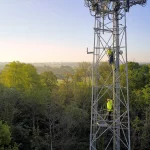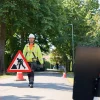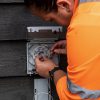18 Months of Village Broadband Disruption Traced to Old TV Set

Residents in the tiny rural village of Aberhosan (Powys, Wales) have finally seen an end to 18-months of unusually slow and unstable broadband ISP connectivity after engineers, working for Openreach (BT), traced the source of the disruption to an old television set, which had been leaking electrical interference (SHINE).
Openreach initially concluded that the local connectivity problems were most likely to have been caused by some old cables, which after a wait were eventually replaced. Unfortunately, this didn’t resolve the problems and so they began sleuthing for electromagnetic interference with the aid of a spectrum analyser.
Regular readers of ISPreview.co.uk will be aware that all sorts of electrical interference can cause disruption for older copper and aluminium (metal) based broadband lines, such as the ADSL and VDSL2 (FTTC) services that cater for Aberhosan. This was particularly common with older style twinkling Christmas Tree Lights, although faulty or poorly shielded AC power adapters have also been known to cause problems for entire communities.
Advertisement
In this case Openreach detected that, at around 7am every day, there was a sudden emission of Single Isolated Impulse Noise (SHINE) that caused interference for the spectrum frequencies being used by local DSL services. SHINE most commonly occurs when a device is powered on or off, which causes a burst of interference and matching disconnections.
Sadly SHINE may also result in slower speeds through Dynamic Line Management (i.e. DLM will automatically drop the line speed in pursuit of stability), if it happens regularly enough. In this case the problem was eventually traced to a local home and an old TV set, as well as one extremely embarrassed owner 🙂 .
Michael Jones, Openreach Engineer, said:
“As a team we’d been facing an ongoing issue in Aberhosan for months. Not being able to solve the fault for our customers left us feeling frustrated and downbeat, but we were determined to get to the bottom it.
As a final resort we decided to bring in a crack squad of engineers from the Chief Engineers Office who were based in other parts of the UK to investigate. Accommodation was understandably hard to find due to the Covid-19 lockdown but we did eventually manage to find a guest house with a field near Llandrindod Wells, so the team camped there and made the 55-mile journey to Aberhosan early the next morning.
Having exhausted all other avenues we wanted to do one final test to see if the fault was being caused by a phenomenon known as SHINE (Single High-level Impulse Noise) where electrical interference is omitted from an appliance that can then have an impact on broadband connectivity.
By using a device called a Spectrum Analyser we walked up and down the village in the torrential rain at 6am to see if we could find an ‘electrical noise’ to support our theory. And at 7am, like clockwork, it happened! Our device picked up a large burst of electrical interference in the village.
The source of the ‘electrical noise’ was traced to a property in the village. It turned out that at 7am every morning the occupant would switch on their old tv which would in-turn knock out broadband for the entire village.
As you can imagine when we pointed this out to the resident, they were mortified that their old second hand TV was the cause of an entire village’s broadband problems, and they immediately agreed to switch it off and not use again.”
Accurately tracing problems like this can be extremely difficult, not least because the event itself may only occur for a brief moment once every day. On the other hand, this was a fairly small community and since the entire village was affected then we’re a bit surprised that it took 18-months to resolve. COVID-19 can probably take some of the blame for that.
Correctly tracing problems like this tends to require expensive equipment, although localised interference issues within your home can often be identified by simply using an old AM/MW radio and tuning it to the 612Khz frequency. You’ll find most devices give off noise patterns when in very close proximity (touching distance), but often the key is whether or not you can still hear that clearly when standing a couple of metres away (may cause problems for DSL).
Advertisement
Over the years we have found that all sorts of electrical devices leak more EM noise than would be ideal, which is one reason why we often recommend trying to position your router and master socket as far away from other non-network devices as possible (obviously this isn’t always possible). Mind you we also recently came across one router from TP-Link that had a surprisingly noisy AC power adapter, so you just never know.
The good news is that future “full fibre” (FTTP) lines won’t suffer from the same problem because they send signals using laser light down optical fibre cables, as opposed to today where electrical signals over wires – made of highly conductive metals like copper or aluminium – can easily pick-up on EM interference in the same spectrum.
UPDATE 10:15am
We’ve added Openreach’s full quote above. The operator has also informed us that the Aberhosan community will be connected to fibre later this year as part of their work with Welsh Government to further expand the fibre broadband network in rural Wales.
Advertisement
Mark is a professional technology writer, IT consultant and computer engineer from Dorset (England), he also founded ISPreview in 1999 and enjoys analysing the latest telecoms and broadband developments. Find me on X (Twitter), Mastodon, Facebook, BlueSky, Threads.net and Linkedin.
« Vodafone UK Add £75 Voucher to Broadband and Apple TV Plans






















































Fantastic story, not for the village mind you. There is something romantic and hilarious about the occupant turning on the TV at 7am everyday, unknowingly causing bandwidth hell for everybody else!
What was the resolution? Did the village all chip in and get the occupant a new tv?
lol that would be brilliant, upgrading them to a 60″ 4K TV
“upgrading them to a 60″ 4K TV” – but they’d only be able to watch Netflix etc. on SD as the ADSL wouldn’t manage anything like 4K.
It was a black and white TV
They got him a new 4K telly and now he’s stealing all the bandwidth.
Piers Morgan arranged for a replacement. Andi Peters will deliver them a new 65″ Ultra HD TV on Monday, live on ITV: https://youtu.be/kjy6GA7OR8g
A possible explanation for the 18 months it took to resolve was the expectation that this was caused by cables which were replaced. That sort of work could take months to complete, especially with lockdown, then followed by residents probably having to open new service issues.
Really not ideal that it took 18 months but with large organisations and different ISPs all having to work through Openreach it isn’t surprising (but is disappointing).
It took 12 months to move on from “reboot your router and wait 30 minutes” that was first line support fix and no supervisors were ever available to talk to, 2nd line support sent everyone half a dozen new routers each that would guarantee resolving the problem, before eventually someone took it seriously.
How on earth they ever thought it was cabling issues I don’t know, surely the very simple act of initially fault finding the issues would have seen all the disconnections happening at the same time every day at a 7am. How would faulty cables with no inteligence or knowledge of the time of day know to start acting up all at the same moment each morning!
I don’t think we are getting all the details on this story as Openreach surely are not that stupid.
So 18 months to resolve, and countless £1000’s spent on labour and materials, surely it would have just been better to replace with FTTP?
Hindsight is a wonderful thing I guess!
See the update above.
Makes me wonder how dangerous that “old TV” must be as they obviously were not designed to emit a Single Isolated Impulse Noise.
Also I wonder if 4g/5g routers are more prone to this type of problem, and it could play a role in the slow home LTE speeds we see in the UK currently?
we had a case where the TalkTalk 12V supply adaptor was causing an electric vehicle not to charge! this was relatively new so age of the device is not really a factor! if an electrical device does go wrong in certain conditions they may still “work” but generate large amounts of RF noise that can affect other equipment, not only broadband! Most domestic equipment is designed with a common mode filter on the supply lines to limit noise but this adds cost to them.
Finding these problems is an engineers nightmare as the frequency does not always need to be in the same band of the affected equipment to make them blind!
Cheap Chinese adaptors are the worst as they have no filtering inside them usually, you cant even guarantee the CE mark on these are valid even if its clearly not fake!
i went to a few houses in my village as all were complaining their bb would go off from 7am to 9 pm every day and by using my old radio (interference would get louder ) and walking up the road found that the fuel station opposite had a faulty sign outside , i went in and asked them to turn it off and hey presto all the bb worked
I would note that you could have probably picked this up with a cheap USB SDR dongle and a laptop. Expect to pay ~£25 for one. The software is generally free. In fact you could have just shipped one with a Raspberry Pi and had it monitor for an extended period of time. It would have been cheaper to post this out to a resident and let them keep it than pay for any accommodation.
Far too much logical thinking there Jonathan :-), we can’t be having that.
Lack of imaginative thinking is the curse of many an organisation. I purchased one myself a few years back. I wanted to reassure myself that 4G really was the problem for the complete loss of my terrestrial TV signal before I blew over £100 on a micro cavity filter. Ordinary filters are no good because I have mux’s on channels 57, 58 and 60, and 4G starts at channel 61.
Technology is moving very fast these days. You have to keep stopping and rethinking why you are doing something they way you are because the underlying assumptions supporting your decision making can easily be no longer true. In this case the equipment for doing RF spectrum analysis (at least in the relevant spectrum here) over extend periods of time is now as cheap as chips. So cheap that posting the equipment out to a consumer on a none return basis is cheaper than an overnight stay.
Actually that is what they use.
Had this on ADSL, five detached houses away. As I monitor continuously, I noticed the connection speed jump from 14 Mbs to 17Mbs. This was when OR were running around disconnecting wires etc. Told them my finding, but they still replaced the wire from the street box to the house, no avail.
Eventually REIN & SHINE turned up, found it and hey presto better speeds for all.
Problem was a dodgy power supply for something or other.
Interestingly the house changed hands, and now a Ham lives there, they will probably suffer from HF interference from the VDSL lines.
Now that Openreach have stopped a TV interfering with internet, perhaps they could stop internet interefering with HF radio.
Applying the specified notches to VDSL would be great, thanks.
They are working on it, it’s called FTTP. Unfortunately it will take some time to roll out across the whole of the UK.
This isn’t as uncommon as you think. I’m quite surprised it took 18 months to pin point. The CEO should have been engaged much sooner.
I’m not saying that with hindsight, but from own direct / indirect experience in such things.
I must admit, I’m super curious what type of TV it was! Must have been a very old CRT of some sort, right?
Could just as easily be a dodgy SMPS in a fairly modern LCD flat panel.
On the Jeremy vine lunchtime show (R2), they had the Chief engineer from Openreach on the programme explaining it. He said (as Jonathan has summised) that it wasn’t an old CRT TV at all – unlike that one shown in the story’s accompanying photo (that was just lazy journalism – all too common these days!) it was a modern LCD model – albeit 5-10 years old. It was an internal component failure (didn’t say which one) causing the REIN.
This made me tickle when I read it. When I worked on REIN cases this was always the case, unfortunately it would only be after as a business we’ve spent months and months putting the rationale together to replace large bits of cable which were fine. Only to then find that the problem was the skill set of the engineers.
No point booking a load of PSTN fault and SFI visits over months to all the same conclusion. Sometimes it’s best to think outside the box, not that Openreach often does that
When I worked for an ISP, we once had a customers VCR causing issues with his broadband. These things do happen.
xmas lights was excellent at making bb drop out ,the person would run the power too close to the phones cables running along the skirting boards
Seems like normal bureaucracy…
“As a final resort we decided to bring in a crack squad of engineers from the Chief Engineers Office who were based in other parts of the UK to investigate”.
Bring out the engineers after 18 months of complaints and replacing expensive items without isolating the root cause first.
So, was the interference some sort of continuous buzz, like arcing of the high-voltage on the CRT (tube) or within the HV compartment? Seems like that would have been evident to the homeowner, in the form of major static on the screen.
Or, could it have been a spurious frequency, within the ADSL frequency band? A simple filter could have helped there.
It tends to be a burst of interference strong enough to disrupt the broadband signal coming down the line. Filters may help, but if it effects the right frequencies then it’s had it.
Rein tends to last a while and is much easier to track, in this case it’s a sudden burst that knocks it all over.
I want to see the TV! I know our brute of a 1300W Panasonic microwave scrambles our wifi every time it’s used.
Possibly scrambles bits of you as well.
I recall reading a very similar story quite some years ago about a TV set disrupting ADSL every morning over quite a large area, only in that instance the cause was eventually tracked down by a rather determined radio ham, and as I recall he ended up buying the TV off the resident, because he wasn’t minded to stop using it!
I think it was a portable CRT TV with an arcing mains switch, so a fire hazard too.
well there you go. my internet goes out all the time too. engineers never find any fault. maybe at the times when it doesnt work, some idiot is watching their 1950s tv.
What an easy way for those with a grudge to spoil their neighbours’ lives!
Easy to resolved this – scrap the crap Dynamic Line Management
Perhaps ISPs could help in limiting the interference problem by not installing Powerline adapters in customer’s homes. Many rural locations utilise what was called Joint Construction when I was a GPO telephone engineer in the 1960s. This is where the electricity and BT cables utilise the same poles, often for hundreds of yards. I still experience intermittent loss of sync on my broadband, despite the Openreach engineers spending several hours rebalancing the copper pairs used for our connection. We are about a mile from our nearest fibre cabinet.In my day the bandwidth of these cable pairs was intended to be 300-3400 Hz.
It might help if OFCOM did something about all the dodgy Chinese manufacturers who are consistently omitting the filtering components from the power supplies that they send over here, even though this is in breach of European EMC regulations, but with self-certification and no monitoring, it’s all too easy for them to get away with. Whether they do this off their own bat to save a few quid and make a bit more profit for themselves, or do it at the request of the Chinese government, or do it because the importers over here are telling them to do it because they know that the useless gits at OFCOM will let them get away with it I really don’t know, but the fact is that the country is being flooded with poorly made crap that doesn’t meet the standards, and the increasing noise levels are probably affecting many people’s reception and internet speeds without them even realising it. Even more annoying is that EU ‘green’ regulations force everyone to use Switched Mode PSUs now to save energy, and these are far more noisy than the old transformer types ever were.
Someone should say that owner to not to be embarrased. It is broadband providers fault, they are the one who should be embarrased. The TV was there even before the company. That should have uncovered long ago. And if someone to offer a new tv, that should be the broadband provider of course.
ITV are giving them a new TV: https://youtu.be/kjy6GA7OR8g
The only one who should be embarrassed is Openreach, who dragged their heels with FTTP for the last decade and a half, and probably resolved about 2 of the numerous REIN/SHINE faults I raised in the 9 years I worked for an ISP (on the occasions I was able to successfully perform the arcane rituals required to summon the correct engineer). Maintaining a copper network is a racket that has gone on too long.
I believe the reason for delay in having FTTP was due to a Government decision back in the nineties.
https://www.techradar.com/uk/news/world-of-tech/how-the-uk-lost-the-broadband-race-in-1990-1224784
It was the bitches fault.
why use twisted copper ? why not fibre-optic ??
If you have any problems with WiFi, ADSL, terrestrial TV, mains supply, etc, just keep a record of what times the problems start and finish.
If it is from 7am to 11pm then suspect a device that is on all day.
If it is around lunchtime for 8 minutes suspect the microwave.
If it is for a few minutes each time but only during office hours, suspect the lift.
If it is for a few minutes each time but occurs all day and night, suspect the fridge/freezer.
If it is dusk till 11pm – suspect LED lights or dimmer switches.
Switching off circuits from the meter can often whittle it down.
Está história está mal contada. Uma tv!?
Que TV? Que tipo de TV?